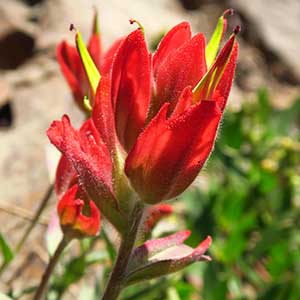Castilleja rubida
Castilleja elmeri
little reddish Indian paintbrush, purple alpine paintbrush, purple paintbrush, Wallowa alpine paintbrush
Elmer's Indian paintbrush, Elmer's paintbrush, Wenatchee Indian paintbrush, Wenatchee paintbrush
several, decumbent, or ascending, unbranched, hairs moderately dense, spreading, short and long, soft, eglandular and glandular.
solitary or few to many, erect to ascending, sometimes slightly curved at base, unbranched, rarely branched, hairs moderately dense, spreading, medium length, soft, mixed with shorter eglandular and stipitate-glandular ones, at least on distal 1/2 of stem.
green to purple, linear to narrowly lanceolate, 0.7–3.2 cm, not fleshy, margins plane, slightly involute, 3–5-lobed, apex narrowly acute to acuminate;
lobes ascending-spreading, narrowly linear to filiform, often curling, often short, apex acute or obtuse.
green, rarely purple-tinged, linear-lanceolate, sometimes linear or lanceolate, 1.3–6.5 cm, not fleshy, margins plane, flat or involute, entire, apex acute.
2.5–6 × 1–2 cm;
bracts purple, deep burgundy, or lavender throughout, rarely pink or yellowish white throughout, sometimes pink or dull whitish on distal margins and apices, oblong, 3–5(–7)-lobed;
lobes spreading, linear, medium length, proximal lobes arising below mid length, center lobe apex rounded to obtuse, lateral ones acute to obtuse.
2.5–9 × 1.5–3 cm;
bracts red, crimson, scarlet, pink, magenta, red-orange, burnt orange, orange, pale yellow, or whitish throughout, or proximally greenish, distally as stated above, oblong, narrowly obovate, elliptic-oblong, or narrowly ovate, 0(–5)-lobed, rarely with 1 or 2 pairs of short, usually distal lobes;
lobes ascending, lanceolate, very short, arising from distal edge, apex rounded to obtuse.
0 mm.
straight, 12–15 mm;
tube 14–16 mm;
abaxial lip and beak exserted;
beak adaxially green, 5–6 mm;
abaxial lip colored as distal portion of bracts, prominent, pouches 3, central one grooved, pouches not strongly inflated, 4–5 mm, 80–100% as long as beak;
teeth erect, appressed to beak, colored as distal portions of bracts, 1.5–2.5 mm.
straight, 20–33 mm;
tubes 13–18 mm;
beak, and sometimes abaxial lip, partially to fully exserted;
beak adaxially green to yellowish, 8–15 mm;
abaxial lip incurved, green, thickened, 2–3 mm, 20–33% as long as beak;
teeth ascending or incurved, green, 0.5–1 mm.
colored as bracts, 10–12 mm; all 4 clefts subequal, 3.5–6.5 mm, 35–55% of calyx length;
lobes broadly linear or linear-triangular, apex obtuse to acute.
proximally green to pale green, distally colored as bracts, 15–25 mm;
abaxial and adaxial clefts 5–14 mm, 33–50% of calyx length, deeper than laterals, lateral 1–4 mm, 6–20% of calyx length;
lobes lanceolate to narrowly triangular, apex rounded to obtuse.
green.
= 48.
Castilleja rubida
Castilleja elmeri
Castilleja rubida is a rare alpine species endemic to a few limestone peaks in the Wallowa Mountains of northeastern Oregon, entirely within the Eagle Cap Wilderness Area. It is likely derived from the C. nana complex, found in the mountains of eastern California and Nevada, but it is amply distinct. Due to its very limited range and small population numbers, C. rubida is a species of conservation concern.
(Discussion copyrighted by Flora of North America; reprinted with permission.)
The bracts and inflorescences of Castilleja elmeri can be red, crimson, scarlet, pink, magenta, red-orange, burnt orange, orange, pale yellow, or whitish. While the coloration is highly variable between local populations, it is usually uniform and consistent within them. It is found primarily in the Wenatchee Mountains of Washington, where it is often on serpentine, but it ranges northward in the Cascades into extreme southern British Columbia, apparently on non-serpentine substrates. Hybrids with C. miniata var. miniata, C. parviflora var. albida, and C. thompsonii have been found in the eastern Cascades of Washington, and a similar hybrid swarm with C. thompsonii is reported from southern British Columbia.
(Discussion copyrighted by Flora of North America; reprinted with permission.)


